FEBRUARY KEY FIGURES
 |  | Feb '05 | Jan 05 to Feb '05 | Feb '04 to Feb '05 |  |
 |  | '000 | % change | % change |  |
|  |
| Short-term visitor arrivals |  |  |  |  |
 | Trend | 465.0 | 1.0 | 9.4 |  |
 | Seasonally adjusted | 463.8 | -2.9 | . . |  |
 | Original | 501.6 | . . | . . |  |
| Short-term resident departures |  |  |  |  |
 | Trend | 389.2 | 0.3 | 13.4 |  |
 | Seasonally adjusted | 377.7 | -1.2 | . . |  |
 | Original | 288.8 | . . | . . |  |
|  |
| . . not applicable |
Visitor arrivals, Short-term
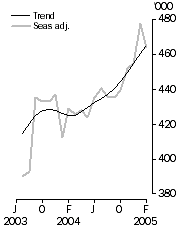
| Resident departures, Short-term
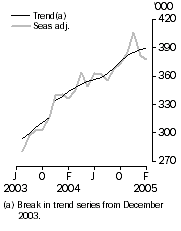
|
FEBRUARY KEY POINTS
TREND ESTIMATES
- The trend estimate for short-term visitor arrivals to Australia during February 2005 (465,000 movements) increased by 1.0% compared with January 2005. This followed monthly increases of 1.2% each for December 2004 and January 2005.
- Short-term visitor arrivals were 9.4% higher than in February 2004 (425,100 movements). It was in February 2004 that the series last troughed.
- During February 2005, short-term resident departures (389,200 movements) increased marginally (0.3%) compared with January 2005. This followed increases of 1.1% for December 2004 and 0.6% for January 2005.
- Short-term resident departures have recorded continued growth since May 2003. Compared with February 2004 (343,300 movements), short-term resident departures are up by 13.4% and up by 36.4% from when they last troughed in April 2003 (285,300 movements). These increases were affected by a break in the trend series.
SEASONALLY ADJUSTED ESTIMATES
- The seasonally adjusted estimate for short-term visitor arrivals during February 2005 (463,800 movements) decreased by 2.9% compared with January 2005. Short-term visitor arrivals increased by 0.7% for December 2004 and 5.0% for January 2005.
- Short-term resident departures for February 2005 (377,700 movements) decreased by 1.2% compared with January 2005 and followed an increase of 5.4% for December 2004 and a decrease of 6.0% for January 2005.
ORIGINAL ESTIMATES
- In original movement terms, there were 501,600 short-term visitor arrivals to Australia and 288,800 short-term resident departures from Australia during February 2005.
NOTES
EARLY ESTIMATES
Early estimates of short-term visitor arrivals for March 2005 will be available on the Australian Bureau of Statistics (ABS) web site on 14 April 2005. These estimates can be accessed by going to the AusStats web page <https://www.abs.gov.au/ausstats> and selecting Publications & Data and then Main Features. Select 34 Migration and then select Short-term Visitor Arrival Estimates, Australia (cat. no. 3401.0.55.001).
DATA NOTES
This publication contains movement data. Care should be taken when interpreting this movement data as 'people'. See paragraph 5 of the Explanatory Notes for more detail.
Calculations of percentage and numeric change are based on unrounded data. See paragraph 12 of the Explanatory Notes for more detail.
CHANGES IN THIS ISSUE
There are no changes in this issue.
EMERGING ISSUES
December 2004 Indian Ocean tsunami - The 26 December 2004 Indian Ocean earthquake and tsunami have impacted on overseas arrivals from, and resident departures to, affected countries. Quantifying the size of this impact in February 2005 overseas arrivals and departures estimates is not yet possible, although seasonally adjusted short-term resident departures to Thailand have shown marked decreases for the last two months. This impact may affect the reliability of recent ABS trend estimates. The ABS will continue to monitor and report on this situation.
INQUIRIES
For further information about these and related statistics, contact the National Information and Referral Service on 1300 135 070 or Anne Ward on Canberra (02) 6252 6871.
MAIN FEATURES
SHORT-TERM VISITOR ARRIVALS
In trend terms, short-term visitor arrivals to Australia in February 2005 have increased by 9.4% when compared with February 2004. Monthly increases have been recorded since March 2004 with visitor arrivals increasing from 425,200 movements in March 2004 to 465,000 movements in February 2005.
The following table presents the top ten source countries (based on original estimates) for short-term visitor arrivals during February 2005. Seasonally adjusted and trend estimates are also presented for these countries, along with the trend percentage change compared with January 2005 and February 2004.
Short-term Visitor Arrivals, Major Source Countries - February 2005 |
|  |
 | Trend | Seasonally Adjusted | Original | Jan 05 to Feb 05 | Feb 04 to Feb 05 |  |
 | '000 | '000 | '000 | Trend % change | Trend % change |  |
|  |
| United Kingdom | 59.3 | 59.6 | 77.6 | 1.9 | 5.7 |  |
| New Zealand | 91.0 | 92.0 | 64.2 | 1.1 | 13.0 |  |
| Japan | 63.1 | 63.0 | 62.2 | -0.4 | 6.2 |  |
| United States of America | 37.2 | 37.6 | 42.5 | 1.2 | 4.9 |  |
| China | 24.8 | (a)np | 38.8 | 1.4 | 23.2 |  |
| Singapore | 23.6 | 22.8 | 24.5 | 1.5 | 12.1 |  |
| Korea | 20.0 | 20.6 | 21.3 | 1.9 | 17.9 |  |
| Hong Kong | 13.0 | 12.7 | 19.3 | 1.4 | 15.0 |  |
| Malaysia | 14.5 | 13.8 | 18.3 | -1.6 | 0.8 |  |
| Germany | 12.0 | 12.0 | 15.5 | 0.2 | 4.3 |  |
|  |
| (a) Seasonally adjusted data for short-term visitor arrivals from China is of an unpublishable standard. |
SHORT-TERM RESIDENT DEPARTURES
In trend terms, short-term resident departures have increased by 13.4% between February 2004 and February 2005. While consecutive monthly increases have been recorded from May 2003 the rate of increase appears to be slowing.
The following table presents the top ten destinations (based on original estimates), for short-term resident departures during February 2005. Seasonally adjusted and trend estimates are also presented for these countries, along with the trend percentage change compared with January 2005 and February 2004.
Short-term Resident Departures, Major Destinations - February 2005 |
|  |
 | Trend | Seasonally Adjusted | Original | Jan 05 to Feb 05 | Feb 04 to Feb 05 |  |
 | '000 | '000 | '000 | Trend % change | Trend % change |  |
|  |
| New Zealand | 71.6 | 70.0 | 69.4 | 0.9 | 10.9 |  |
| United States of America | 32.8 | 31.8 | 21.4 | 0.4 | 11.7 |  |
| Indonesia | 33.2 | 33.5 | 20.8 | 4.3 | 12.7 |  |
| United Kingdom | 31.2 | 32.7 | 17.5 | -0.1 | 1.9 |  |
| Hong Kong | 15.2 | 14.8 | 13.7 | 2.0 | 31.1 |  |
| Singapore | 16.3 | 15.6 | 12.9 | 1.7 | 34.9 |  |
| China | 18.0 | 17.8 | 12.7 | 1.5 | 38.3 |  |
| Malaysia | 14.9 | 16.1 | 12.6 | 3.7 | 27.7 |  |
| Fiji | 16.8 | 16.4 | 11.0 | 0.5 | 25.2 |  |
| Thailand | 14.9 | 12.3 | 10.4 | -4.8 | -0.7 |  |
|  |
SHORT-TERM TRAVEL - UNITED KINGDOM AND AUSTRALIA
Short-term visitor arrivals
According to trend estimates, the number of short-term visitor arrivals from the United Kingdom represented 13% of all short-term visitor arrivals to Australia in February 2005 and is the highest number of arrivals ever recorded (59,300 movements). Over the past ten years the trend has been upwards with the February 2005 trend estimate for arrivals from the United Kingdom being 6% higher than in February 2004 and 96% higher than in February 1995.
UNITED KINGDOM, Short-term Visitor Arrivals
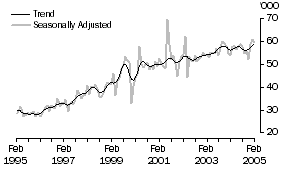
In original terms, 57% of the visitors from the United Kingdom in February 2005 stated holiday as the main reason for journey, compared with 55% of all short-term visitor arrivals. The median age of visitors from the United Kingdom was 49 years (38 years for all visitors) and the median duration of stay was 18 days (10 days for all visitors).
Short-term resident departures
Trend estimates show that the number of residents departing Australia short-term for the United Kingdom represented 8% of all short-term resident departures in February 2005. While the trend in departures has been upwards over the past ten years it has fluctuated. Currently there are signs that the number of short-term resident departures to the United Kingdom has plateaued. The number of short-term residents departing Australia for the United Kingdom in February 2005 was 2% higher than in February 2004 and 41% higher than in February 1995.
UNITED KINGDOM, Short-term Resident Departures
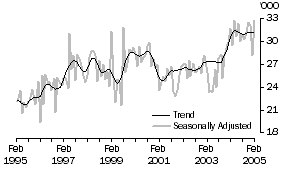
In original terms, Australian residents departing to the United Kingdom stated holiday (31%) and visiting friends and relatives (31%) as the main reasons for journey. In comparison, the main reasons for journey stated by all residents departing were holiday (42%) and visiting friends and relatives (25%). The median age of residents departing to the United Kingdom was 39 years (42 years for all residents) and the median duration of stay was 22 days (14 days for all residents).
PERMANENT AND LONG-TERM MOVEMENTS
There were 9,780 permanent (settler) arrivals into Australia during February 2005, an increase of 11.0% when compared with February 2004 (8,820 movements). Settlers born in New Zealand accounted for the largest proportion (16%) followed by the United Kingdom (14%) and China (10%).
Statistics on overseas arrivals and departures relate to the number of movements of travellers rather than the number of travellers. Therefore, care should be taken when using long-term arrivals data as it is known some individuals who travel multiple times in a year are counted each time they cross Australia's borders (see paragraph 5 of the Explanatory Notes). Long-term arrivals in this publication are not an appropriate source of migration statistics. For further information refer to Australian Demographic Statistics (cat. no. 3101.0).
There were 4,880 Australian residents departing permanently from Australia during February 2005, an increase of 6.4% when compared with February 2004 (4,590 movements).
STATISTICAL SIGNIFICANCE
The above presentation of movements in estimates does not take into account whether the change in movement is statistically significant. Care should be taken when interpreting the impact of numeric and/or percentage change. Please see the Standard Errors section of this issue for more detail.
SEASONALLY ADJUSTED AND TREND ESTIMATES
INTRODUCTION
Seasonally adjusted and trend estimates add to the understanding of Overseas Arrivals and Departures (OAD) statistics. Seasonally adjusted estimates allow users to analyse short-term movements including irregular impacts on the series, while trend estimates provide a better method to analyse and monitor the underlying direction of the short-term movement series. In most cases, the trend series is the best source of information on the long-term direction of these statistics.
SHORT-TERM VISITOR ARRIVALS
Selected Source Countries
The graphs presented below illustrate the impact of the Rugby World Cup on arrivals from the United Kingdom in the latter half of 2003, and the significant impact of Severe Acute Respiratory Syndrome (SARS) on arrivals from Japan earlier in 2003.
United Kingdom
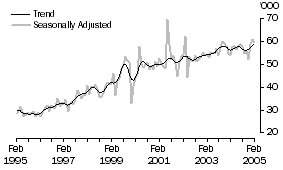 Japan
Japan
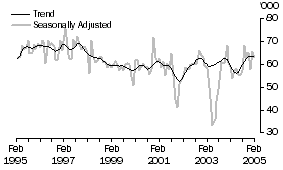
SHORT-TERM RESIDENT DEPARTURES
Selected destinations
For residents departing to the United States of America the graph illustrates the effect that the terrorist attacks in that country on 11 September 2001 had on short-term departures of Australian residents to the United States of America. The graph for New Zealand illustrates that departures of Australian residents have been trending upwards since May 2003.
United States of America
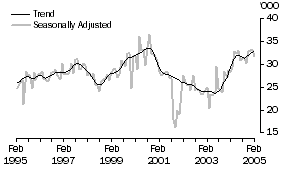 New Zealand
New Zealand
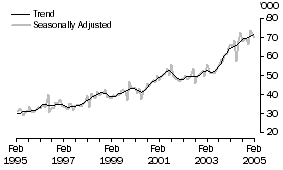
 Print Page
Print Page
 Print All
Print All